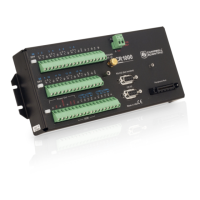Error Calculations with Input Reversal = False
µV error = gain term + offset term
= (44500 µV * 0.12%) + (3 * 66.7 µV + 2.0 µV)
= 53.4 µV + 200 µV
= 7.25 µV (= 7.25 °C)
Ground Looping Error
When the thermocouple measurement junction is in electrical contact with the
object being measured (or has the possibility of making contact), a differential
measurement should be made to avoid ground looping.
Noise Error
The typical input noise on the ±2_5 mV range for a differential measurement with
16.67 ms integration and input reversal is 0.19 μV RMS. On a type-T
thermocouple (approximately 40 μV/°C), this is 0.005°C.
Note This is an RMS value; some individual readings will vary by greater than
this.
Thermocouple Polynomial Error
NIST Monograph 175 gives high-order polynomials for computing the output
voltage of a given thermocouple type over a broad range of temperatures. To
speed processing and accommodate the CR1000 math and storage capabilities,
four separate 6th-order polynomials are used to convert from volts to temperature
over the range covered by each thermocouple type. The table Limits of Error on
CR1000 Thermocouple Polynomials
(p. 334) gives error limits for the thermocouple
polynomials.
Table 68. Limits of Error on CR1000 Thermocouple Polynomials
TC
Type
Range °C
Limits of Error °C
Relative to NIST
Standards
T –270
to 400
–270 to –200 18 @ –270
–200 to –100 ±0.08
–100 to 100 ±0.001
100 to 400 ±0.015
J –150
to 760
±0.008
–100 to 300 ±0.002
E –240
to 1000
–240 to –130 ±0.4
–130 to 200 ±0.005
334

